
Concept explainers
(a)
Interpretation: The structure corresponding to the given name is to be drawn.
Concept introduction: To derive the structure of the compound from its IUPAC name, one should follow the given three steps. The first step involves the identification of parent name and functional group found at the end of the name. The second step is numbering of carbon skeleton in either direction. The third step is addition of substituents at appropriate carbon atoms.
Answer to Problem 9.42P
The structure corresponding to the given name is,
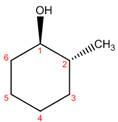
Explanation of Solution
The name of the given compound is

Figure 1
The structure corresponding to the given name is shown in Figure 1.
(b)
Interpretation: The structure corresponding to the given name is to be drawn.
Concept introduction: To derive the structure of the compound from its IUPAC name, one should follow the given three steps. The first step involves the identification of parent name and functional group found at the end of the name. The second step is numbering of carbon skeleton in either direction. The third step is addition of substituents at appropriate carbon atoms.
Answer to Problem 9.42P
The structure corresponding to the given name is,
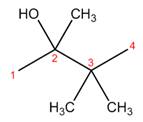
Explanation of Solution
The name of the given compound is
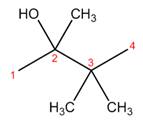
Figure 2
The structure corresponding to the given name is shown in Figure 2.
(c)
Interpretation: The structure corresponding to the given name is to be drawn.
Concept introduction: To derive the structure of the compound from its IUPAC name, one should follow the given three steps. The first step involves the identification of parent name and functional group found at the end of the name. The second step is numbering of carbon skeleton in either direction. The third step is addition of substituents at appropriate carbon atoms.
Answer to Problem 9.42P
The structure corresponding to the given name is,
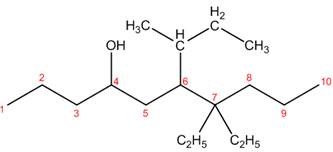
Explanation of Solution
The name of the given compound is

Figure 3
The structure corresponding to the given name is shown in Figure 3.
(d)
Interpretation: The structure corresponding to the given name is to be drawn.
Concept introduction: To derive the structure of the compound from its IUPAC name, one should follow the given three steps. The first step involves the identification of parent name and functional group found at the end of the name. The second step is numbering of carbon skeleton in either direction. The third step is addition of substituents at appropriate carbon atoms.
Answer to Problem 9.42P
The structure corresponding to the given name is,

Explanation of Solution
The name of the given compound is

Figure 4
The structure corresponding to the given name is shown in Figure 4.
(e)
Interpretation: The structure corresponding to the given name is to be drawn.
Concept introduction: To derive the structure of the compound from its IUPAC name, one should follow the given three steps. The first step involves the identification of parent name and functional group found at the end of the name. The second step is numbering of carbon skeleton in either direction. The third step is addition of substituents at appropriate carbon atoms.
Answer to Problem 9.42P
The structure corresponding to the given name is,
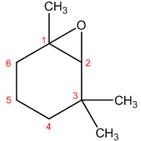
Explanation of Solution
The name of the given compound is

Figure 5
The structure corresponding to the given name is shown in Figure 5.
(f)
Interpretation: The structure corresponding to the given name is to be drawn.
Concept introduction: To derive the structure of the compound from its IUPAC name, one should follow the given three steps. The first step involves the identification of parent name and functional group found at the end of the name. The second step is numbering of carbon skeleton in either direction. The third step is addition of substituents at appropriate carbon atoms.
Answer to Problem 9.42P
The structure corresponding to the given name is,

Explanation of Solution
The name of the given compound is

Figure 6
The structure corresponding to the given name is shown in Figure 6.
(g)
Interpretation: The structure corresponding to the given name is to be drawn.
Concept introduction: To derive the structure of the compound from its IUPAC name, one should follow the given three steps. The first step involves the identification of parent name and functional group found at the end of the name. The second step is numbering of carbon skeleton in either direction. The third step is addition of substituents at appropriate carbon atoms.
The naming of chiral center and geometric isomers are based on Cahn-Ingold-Prelog priority rules. If the priority assigned to each group attached to the chirality center in a molecule is in a clockwise direction, then it is the R-stereoisomer, and if this is counter-clockwise, then it is the S-stereoisomer. R and S-stereoisomer are mirror images of each other.
Answer to Problem 9.42P
The structure corresponding to the given name is,

Explanation of Solution
The name of the given compound is

Figure 7
The structure corresponding to the given name is shown in Figure 7.
(h)
Interpretation: The structure corresponding to the given name is to be drawn.
Concept introduction: To derive the structure of the compound from its IUPAC name, one should follow the given three steps. The first step involves the identification of parent name and functional group found at the end of the name. The second step is numbering of carbon skeleton in either direction. The third step is addition of substituents at appropriate carbon atoms.
The naming of chiral center and geometric isomers are based on Cahn-Ingold-Prelog priority rules. If the priority assigned to each group attached to the chirality center in a molecule is in a clockwise direction, then it is the R-stereoisomer, and if this is counter-clockwise, then it is the S-stereoisomer. R and S-stereoisomer are mirror images of each other.
Answer to Problem 9.42P
The structure corresponding to the given name is,
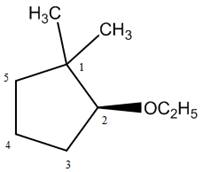
Explanation of Solution
The name of the given compound is

Figure 8
The structure corresponding to the given name is shown in Figure 8.
(i)
Interpretation: The structure corresponding to the given name is to be drawn.
Concept introduction: To derive the structure of the compound from its IUPAC name, one should follow the given three steps. The first step involves the identification of parent name and functional group found at the end of the name. The second step is numbering of carbon skeleton in either direction. The third step is addition of substituents at appropriate carbon atoms.
Answer to Problem 9.42P
The structure corresponding to the given name is,
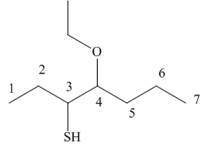
Explanation of Solution
The name of the given compound is

Figure 9
The structure corresponding to the given name is shown in Figure 9.
(j)
Interpretation: The structure corresponding to the given name is to be drawn.
Concept introduction: To derive the structure of the compound from its IUPAC name, one should follow the given three steps. The first step involves the identification of parent name and functional group found at the end of the name. The second step is numbering of carbon skeleton in either direction. The third step is addition of substituents at appropriate carbon atoms.
Answer to Problem 9.42P
The structure corresponding to the given name is,
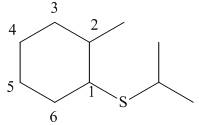
Explanation of Solution
The name of the given compound is

Figure 10
The structure corresponding to the given name is shown in Figure 10.
Want to see more full solutions like this?
Chapter 9 Solutions
ORG.CHEMISTRY W/ACCESS+MODEL KIT PKG
- d. Reaction with CH3MgI (excess), ether; then H+/H2O e. Reaction with LiAlH4, ether; then H+/H2O f. Reaction with DIBAL (diisobutylaluminum hydride), toluene, low temperature; then H+/H2Oarrow_forwardUsing chair confirmations, draw the final product of each molecule. Pls explain how are you arrived at the answerthank you!arrow_forward1. Give the major product for the reactions in d and e. 2. Give the name of the structure in f.arrow_forward
- reactions and products for C9H8O4 C9H8O4 + O2 --> C9H8O4 + H2O --> C9H8O4 + HCl --> C9H8O4 + OH- --> C9H8O4 + Na --> C9H8O4 + F -->arrow_forwardthe reagents are LiAlH4 Et2O / H2O, can you please redo with these reagents? Thank you.arrow_forwardHow to draw product C? Please give detailed structure for the product Carrow_forward
- Bicyclo[2.2.1]heptan-7-one + PCC (in CH₂Cl₂) => A.) Bicyclo[2.2.1]heptan-7-ol B.) Bicyclo[2.2.1]heptanoic acid C.) Cyclohexanecarbaldehyde D.) All the given choices are possible products E.) No reactionarrow_forwardThe stereochemistry of the products of reduction depends on the reagent used, with this in mind, how would you convert 3,3-dimethylbutan-2-one [CH3COC(CH3)3] to: (a) racemic 3,3-dimethylbutan-2-ol [CH3CH(OH)C(CH3)3]; (b) only (R)-3,3- dimethylbutan-2-ol; (c) only (S)-3,3-dimethylbutan-2-ol?arrow_forward#20 B Draw structural formulas for all possible carbocations formed by the reaction of each alkene with HCl.arrow_forward
- KMnO4, warm, conc'd reacts with hept-1-ene to yield __________. CO2, hex-1-ene CO2, hexanoic acid Formic acid, pentanoic acid Ethanoic acid, pentanal Formic acid, hexanonearrow_forwardComplete the following reaction: Pb+2 + SO4 -2 ---------------arrow_forwardcis-Cyclohexane-1,2-diol can be synthesized from cyclohexene by using which reagent? a.O3 b.OsO4 c.H2SO4 d.mCPBAarrow_forward

 Organic Chemistry: A Guided InquiryChemistryISBN:9780618974122Author:Andrei StraumanisPublisher:Cengage Learning
Organic Chemistry: A Guided InquiryChemistryISBN:9780618974122Author:Andrei StraumanisPublisher:Cengage Learning

